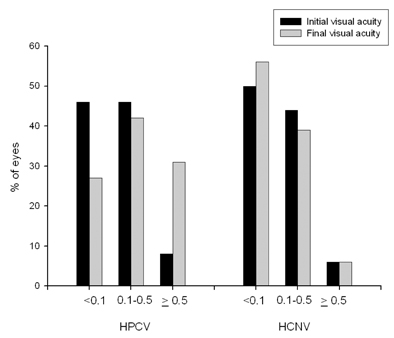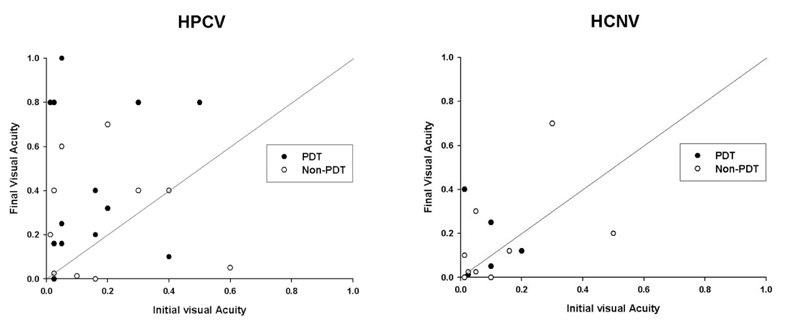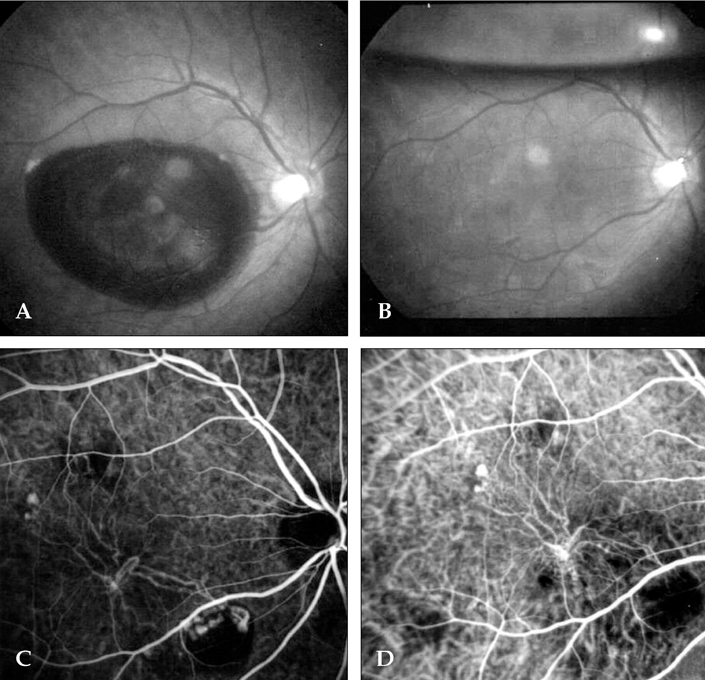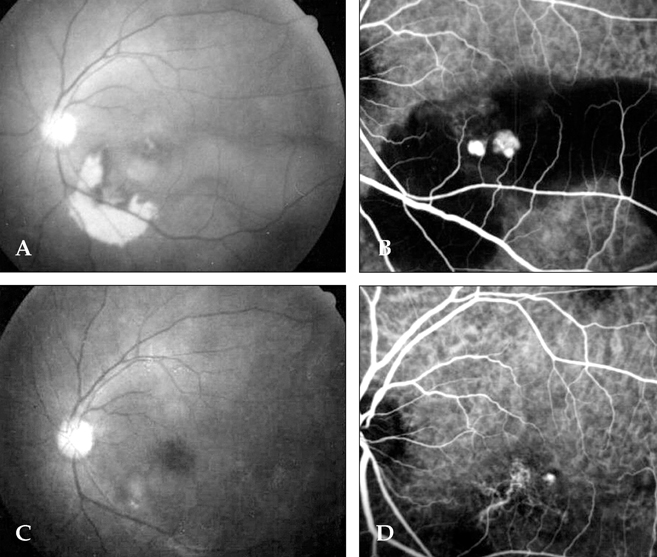Yonsei Med J.
2007 Apr;48(2):225-232. 10.3349/ymj.2007.48.2.225.
Polypoidal Choroidal Vasculopathy in Korean Patients with Large Submacular Hemorrhage
- Affiliations
-
- 1The Institute of Vision Research, Department of Ophthalmology, Yonsei University College of Medicine, Seoul, Korea.
- 2Department of Ophthalmology, Ilsan Paik Hospital, College of Medicine, Inje University, Goyang, Gyeonggi-do, Korea. sunglee@yumc.yonsei.ac.kr
- KMID: 1779524
- DOI: http://doi.org/10.3349/ymj.2007.48.2.225
Abstract
- PURPOSE
To determine and compare the clinical characteristics, visual prognosis and treatment of hemorrhagic polypoidal choroidal vasculopathy (HPCV) with those of hemorrhagic choroidal neovascularization (HCNV) due to age-related macular degeneration (ARMD). MATERIALS AND METHODS: Retrospective analysis of 44 consecutive eyes with a submacular hemorrhage comprising more than 50% of the neovascular lesion. Patients were diagnosed as having HPCV or HCNV on the basis of indocyanine green angiography. RESUTLS: Of the 44 eyes with submacular hemorrhage, 26 were classified as HPCV and 18 as HCNV. The baseline patient characteristics were similar for both groups. At the final follow-up the HPCV group had 17 eyes showing visual improvement, four showing maintained vision, and five showing visual deterioration. In contrast, the HCNV group had four eyes showing visual improvement, one showing maintained vision, and 13 showing visual deterioration. Visual acuity of < 0.1 at follow-up was found in 7 (27%) of HPCV eyes and 10 (56%) of HCNV eyes. PDT was performed in 15 HPCV eyes, of which 13 (87%) showed improvement or no change in visual acuity, while only 2 (22%) of the 9 HCNV eyes responded similarly after PDT. Eyes treated with PDT did not have better outcomes compared to eyes that underwent other types of treatment (Fisher's exact test, p > 0.05). CONCLUSION: PCV accounts for the largest proportion of submacular hemorrhage in Koreans. PCV showed a better visual prognosis than CNV.
Keyword
MeSH Terms
-
Vision Disorders/etiology
Treatment Outcome
Tissue Plasminogen Activator/therapeutic use
Retinal Hemorrhage/drug therapy/*epidemiology
Photochemotherapy
Middle Aged
Male
Macular Degeneration/drug therapy/epidemiology
Korea/epidemiology
Humans
Follow-Up Studies
Female
Choroidal Neovascularization/drug therapy/*epidemiology
Figure
Reference
-
1. Avery RL, Fekrat S, Hawkins BS, Bressler NM. Natural history of subfoveal subretinal hemorrhage in age-related macular degeneration. Retina. 1996. 16:183–189.2. Bennett SR, Folk JC, Blodi CF, Klugman M. Factors prognostic of visual outcome in patients with subretinal hemorrhage. Am J Ophthalmol. 1990. 109:33–37.3. Berrocal MH, Lewis ML, Flynn HW Jr. Variations in the clinical course of submacular hemorrhage. Am J Ophthalmol. 1996. 122:486–493.4. Ciardella AP, Donsoff IM, Huang SJ, Costa DL, Yannuzzi LA. Polypoidal choroidal vasculopathy. Surv Ophthalmol. 2004. 49:25–37.5. Kwok AK, Lai TY, Chan CW, Neoh EL, Lam DS. Polypoidal choroidal vasculopathy in Chinese patients. Br J Ophthalmol. 2002. 86:892–897.6. Moorthy RS, Lyon AT, Rabb MF, Spaide RF, Yannuzzi LA, Jampol LM. Idiopathic polypoidal choroidal vasculopathy of the macula. Ophthalmology. 1998. 105:1380–1385.7. Sho K, Takahashi K, Yamada H, Wada M, Nagai Y, Otsuji T, et al. Polypoidal choroidal vasculopathy: incidence, demographic features, and clinical characteristics. Arch Ophthalmol. 2003. 121:1392–1396.8. Uyama M, Wada M, Nagai Y, Matsubara T, Matsunaga H, Fukushima I, et al. Polypoidal choroidal vasculopathy: natural history. Am J Ophthalmol. 2002. 133:639–648.9. Yannuzzi LA, Ciardella A, Spaide RF, Rabb M, Freund KB, Orlock DA. The expanding clinical spectrum of idiopathic polypoidal choroidal vasculopathy. Arch Ophthalmol. 1997. 115:478–485.10. Terasaki H, Miyake Y, Suzuki T, Nakamura M, Nagasaka T. Polypoidal choroidal vasculopathy treated with macular translocation: clinical pathological correlation. Br J Ophthalmol. 2002. 86:321–327.11. Ahuja RM, Stanga PE, Vingerling JR, Reck AC, Bird AC. Polypoidal choroidal vasculopathy in exudative and hemorrhagic pigment epithelial detachments. Br J Ophthalmol. 2000. 84:479–484.12. Uyama M, Matsubara T, Fukushima I, Mtsunaga H, iwashita K, Nagai Y, et al. Idiopathic polypoidal choroidal vasculopathy in Japanese patients. Arch Ophthalmol. 1999. 117:1035–1042.13. Bressler NM; Treatment of Age-Related Macular Degeneration with Photodynamic Therapy (TAP) Study Group. Photodynamic therapy of subfoveal choroidal neovascularization in age-related macular degeneration with verteporfin: two-year results of 2 randomized clinical trials-TAP report 2. Arch Ophthalmol. 2001. 119:198–207.14. Lewis H. Intraoperative fibrinolysis of submacular hemorrhage with tissue plasminogen activator and surgical drainage. Am J Ophthalmol. 1994. 118:559–568.15. Handwerger BA, Blodi BA, Chandra SR, Olsen TW, Stevens TS. Treatment of submacular hemorrhage with low-dose intravitreal tissue plasminogen activator injection and pneumatic displacement. Arch Ophthalmol. 2001. 119:28–32.16. Hassan AS, Johnson MW, Schneiderman TE, Regillo CD, Tornambe PE, Poliner LS, et al. Management of submacular hemorrhage with intravitreous tissue plasminogen activator injection and pneumatic displacement. Ophthalmology. 1999. 106:1900–1907.17. Haupert CL, McCuen BW 2nd, Jaffe GJ, Steuer ER, Cox TA, Toth CA, et al. Pars plana vitrectomy, subretinal injection of tissue plasminogen activator, and fluid-gas exchange for displacement of thick submacular hemorrhage in age-related macular degeneration. Am J Ophthalmol. 2001. 131:208–215.18. Lee SC, Seong YS, Kim SS, Koh HJ, Kwon OW. Photodynamic therapy with verteporfin for polypoidal choroidal vasculopathy of the macula. Ophthalmologica. 2004. 218:193–201.19. Rogers AH, Greenberg PB, Martidis A, Puliafito CA. Photodynamic therapy of polypoidal choroidal vasculopathy. Ophthalmic Surg Lasers Imaging. 2003. 34:60–63.20. Spaide RF, Donsoff I, Lam DL, Yannuzzi LA, Jampol LM, Slakter J, et al. Treatment of polypoidal choroidal vasculopathy with photodynamic therapy. Retina. 2002. 22:529–535.21. Chan WM, Lam DS, Lai TY, Liu DT, Li KK, Yao Y, et al. Photodynamic therapy with verteporfin for symptomatic polypoidal choroidal vasculopathy: one-year results of a prospective case series. Ophthalmology. 2004. 111:1576–1584.22. Gelisken F, Inhoffen W, Karim-Zoda K, Grisanti S, Partsch M, Voelker M, et al. Subfoveal hemorrhage after verteporfin photodynamic therapy in treatment of choroidal neovascularization. Graefes Arch Clin Exp Ophthalmol. 2005. 243:198–203.23. Arnold JJ, Blinder KJ, Bressler NM, Bressler SB, Burdan A, Haynes L, et al. Acute severe visual acuity decrease after photodynamic therapy with verteporfin: case reports from randomized clinical trials-TAP and VIP report No. 3. Am J Ophthalmol. 2004. 137:683–696.
- Full Text Links
- Actions
-
Cited
- CITED
-
- Close
- Share
- Similar articles
-
- Anti-vascular Endothelial Growth Factor Monotherapy and Pneumatic Displacement for Submacular Hemorrhage in Polypoidal Choroidal Vasculopathy
- Predictive Factors for Submacular Hemorrhage in Age-related Macular Degeneration: A Retrospective Study
- Development of Submacular Hemorrhage in Neovascular Age-related Macular Degeneration: Influence on Visual Prognosis in a Clinical Setting
- Photodynamic Therapy with Verteporfin in Polypoidal Choroidal Vasculopathy
- Intravitreal Anti-vascular Endothelial Growth Factor for Newly Diagnosed Symptomatic Polypoidal Choroidal Vasculopathy with Extrafoveal Polyps





